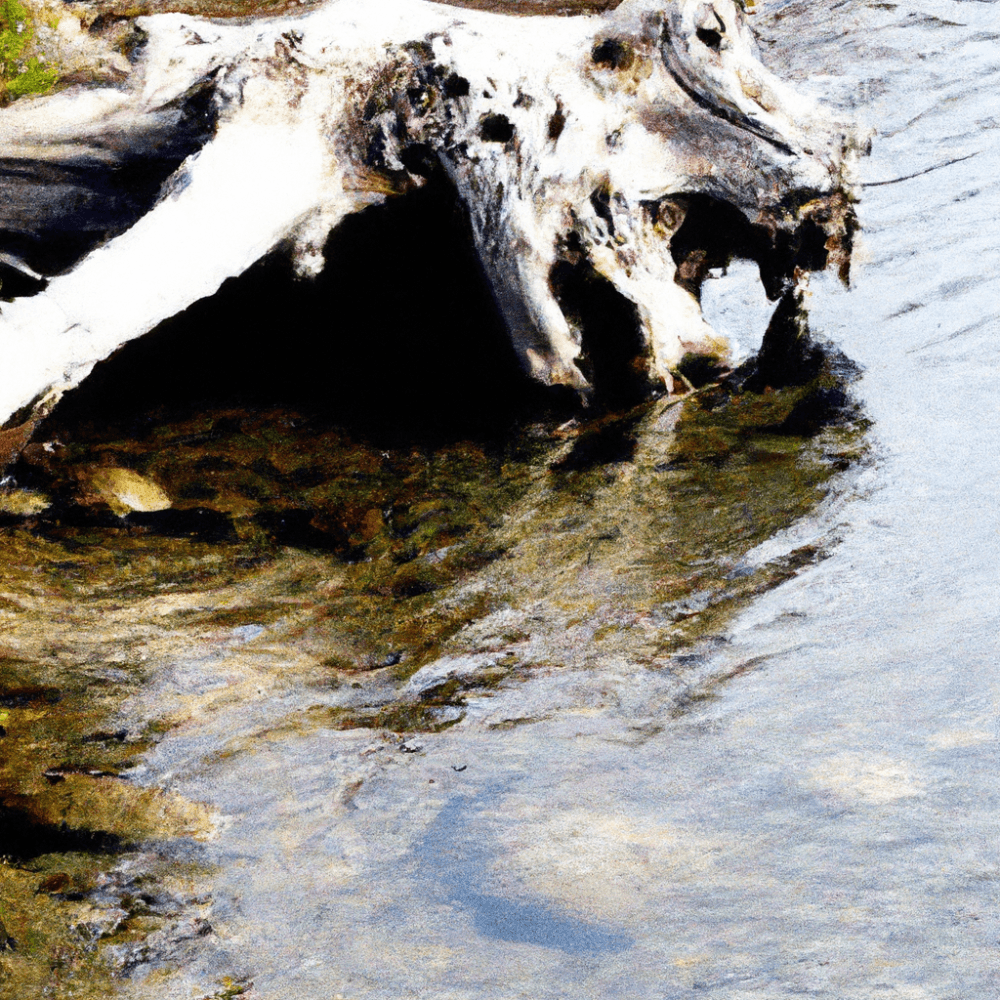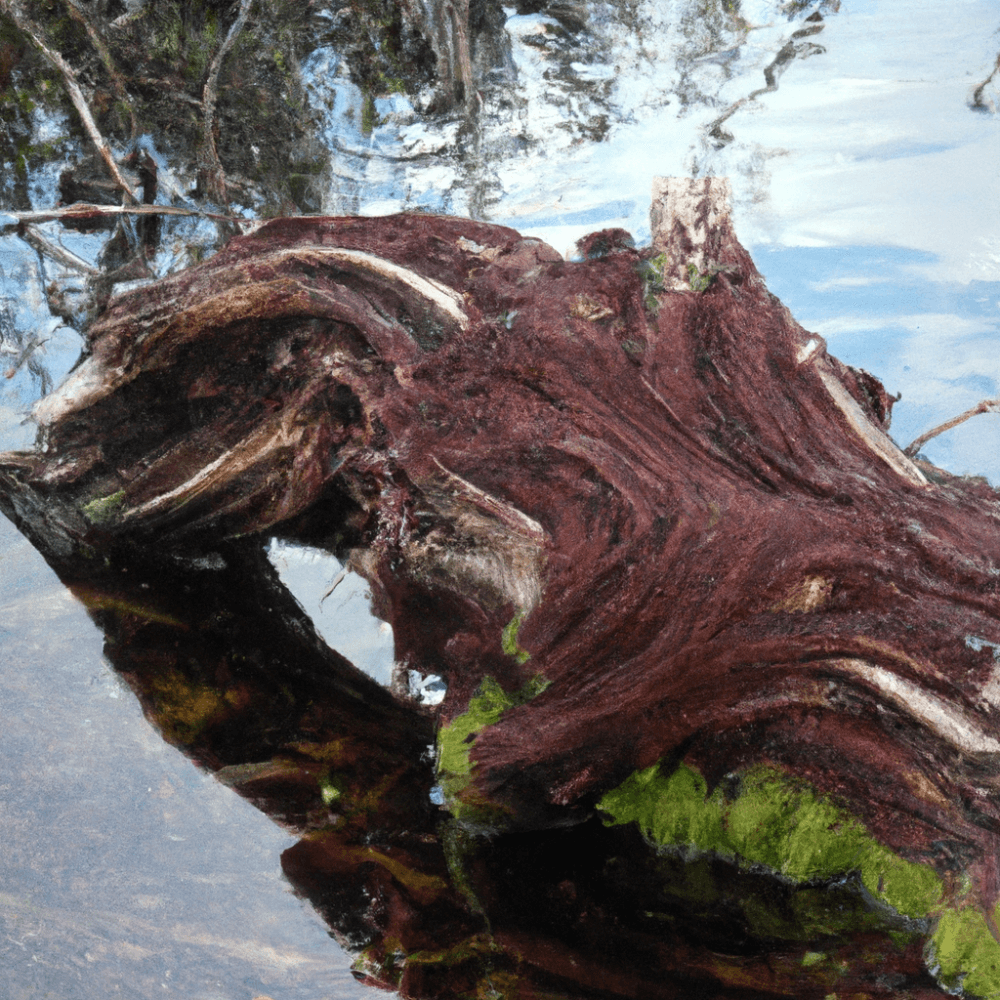Imagine strolling along a picturesque beach, captivated by the beauty of the driftwood scattered along the shoreline. But have you ever wondered if this natural treasure could be responsible for the unsightly presence of algae in our waters? In this article, we will explore the intriguing question of whether driftwood plays a role in the growth of algae, unravelling the mystery behind this delicate ecosystem and shedding light on the potential impact of this seemingly innocent beachside phenomenon.

Overview of Driftwood and Algae
What is driftwood?
Driftwood refers to pieces of wood that have been washed onto shores or accumulated in bodies of water like rivers, lakes, and oceans. This wood may originate from various sources, including fallen trees, branches, or debris carried by currents. Driftwood can have different shapes, sizes, and states of decay, depending on its age and exposure to environmental conditions.
What is algae?
Algae are diverse, photosynthetic organisms that can be found in various aquatic environments, including freshwater, marine, and brackish water. They encompass a wide range of species, from microscopic unicellular organisms to large, multicellular seaweeds. Algae play important ecological roles, serving as primary producers and providing food and habitat for numerous aquatic organisms.
The potential connection between driftwood and algae
Driftwood and algae can be linked through their interactions in aquatic ecosystems. Driftwood can act as a natural habitat for algae, providing a substrate for growth and serving as a source of nutrient enrichment. Algal growth, in turn, can be influenced by factors such as nutrient availability, light, temperature, and water flow. Understanding the relationship between driftwood and algae is crucial for managing potential issues, such as algal blooms, that may arise in aquatic environments.
Driftwood as a Natural Habitat for Algae
The role of driftwood in aquatic ecosystems
Driftwood plays a significant ecological role in aquatic ecosystems. It acts as a physical structure, providing shelter, hiding places, and attachment sites for various organisms, including algae. The presence of driftwood can enhance biodiversity by creating microhabitats and promoting the colonization of different species. As a natural component of aquatic environments, driftwood contributes to the overall complexity and functioning of ecosystems.
Driftwood as a substrate for algal growth
Driftwood provides a substrate for algal attachment and growth. Algae, especially those with holdfasts or structures for anchoring, can utilize the surfaces of driftwood to establish themselves and thrive. The irregular surfaces of driftwood offer ample opportunities for algae to secure themselves, ensuring access to light and nutrients. The composition and texture of driftwood can also influence algal community composition and diversity.
Nutrient enrichment provided by driftwood
Driftwood can serve as a source of nutrient enrichment in aquatic ecosystems. As the wood decays, it releases organic matter, including carbon, nitrogen, and phosphorus, into the surrounding water. These nutrients are essential for algal growth and can support the proliferation of algae. The decomposition of driftwood contributes to nutrient cycling, providing a continuous supply of nutrients that can fuel algal blooms under certain conditions.
Algal Growth and Nutrient Availability
The importance of nutrients for algal growth
Nutrients, including nitrogen and phosphorus, are vital for algal growth and photosynthesis. They act as limiting factors in many aquatic environments, meaning that their availability can determine the extent and rate of algal proliferation. Adequate nutrient concentrations, primarily in the form of nitrates and phosphates, are necessary to support the metabolic processes of algae and drive their growth.
Nutrient cycling in aquatic environments
Aquatic ecosystems undergo nutrient cycling processes, which involve the uptake, transformation, and release of nutrients by different organisms. Algae play a crucial role in this cycling, as they assimilate nutrients from the water, use them for growth and metabolism, and then release excess nutrients back into the environment. This cycling ensures a constant supply of nutrients for algal communities and contributes to the overall stability of ecosystems.
Nutrient release from decaying driftwood
Decaying driftwood acts as a source of nutrient release in aquatic environments. As the wood breaks down, it releases organic matter and associated nutrients into the water. These released nutrients can be directly taken up by algae, fueling their growth and contributing to the development of algal biomass. The decomposition of driftwood, therefore, plays a significant role in the nutrient dynamics of aquatic ecosystems and can influence algal proliferation.
Factors Influencing Algal Growth
Light availability and its effect on algal growth
Light availability is a crucial factor influencing algal growth. Algae require light for photosynthesis, a process through which they convert sunlight into energy. Driftwood placement can affect light penetration into the water column, as it may create shaded areas beneath or near the wood. Algal species that thrive in low-light conditions may be favored in such areas, leading to localized increases in algal growth.
Temperature and its influence on algal proliferation
Temperature plays a critical role in algal proliferation. Algae have specific temperature ranges in which they thrive, and variations in water temperature can affect their growth rates. Driftwood can influence water temperature by providing shade or warm surfaces that absorb solar radiation. These temperature variations near or under driftwood can create microclimates that may favor certain algal species over others.
Water flow and its impact on algal colonization
Water flow is an essential factor influencing algal colonization and growth. Driftwood can alter water flow patterns by creating eddies, redirecting currents, or providing sheltered areas. These altered flow patterns can affect the distribution and abundance of algae. Some algal species may be more adapted to high-flow environments and may proliferate in areas with increased water movement, while others may prefer calmer regions created by driftwood.

The Relationship Between Driftwood and Algal Blooms
Conditions favoring algal blooms
Algal blooms are characterized by excessive growth and accumulation of algae in a water body. Several conditions can favor algal blooms, including high nutrient availability, favorable light and temperature conditions, and limited grazing or control by predators. When these conditions align, algae can experience rapid proliferation, resulting in the formation of dense mats or floating masses known as algal blooms.
Potential contribution of driftwood to algal blooms
Driftwood can potentially contribute to the occurrence and severity of algal blooms. As mentioned earlier, driftwood acts as a source of nutrient enrichment, supplying organic matter and nutrients that can fuel algal growth. Additionally, the physical structure provided by driftwood can trap and accumulate floating algae, further enhancing their growth and potential for bloom formation. Driftwood-associated algal blooms may occur in localized areas with high concentrations of wood debris.
Case studies and research on driftwood-associated algal blooms
Scientific studies have investigated the relationship between driftwood and algal blooms in different aquatic environments. For example, research conducted in lakes and rivers has shown that driftwood accumulation can contribute to the development of algal blooms. These studies have highlighted the importance of considering driftwood dynamics and its role in nutrient cycling when managing and predicting algal bloom events.
Negative Effects of Algal Blooms
Reduced water quality and clarity
Algal blooms can have detrimental effects on water quality and clarity. As algae proliferate, they can create dense mats or scums that obstruct sunlight penetration and reduce water clarity. This reduction in clarity can negatively impact aquatic organisms that rely on light, such as submerged plants, while also affecting the aesthetic value of water bodies for recreational activities like swimming and boating.
Impacts on aquatic organisms and ecosystems
Algal blooms can have significant impacts on aquatic organisms and ecosystems. The dense growth of algae can lead to oxygen depletion in the water, known as hypoxia, which can harm fish and other aquatic organisms. Algae may also produce toxins that can be harmful to aquatic life and disrupt ecosystem dynamics. Additionally, the excessive growth of algae can outcompete native species, altering the ecological balance of aquatic communities.
Threats to human health and recreational activities
Certain algal species, such as cyanobacteria, can produce toxins known as cyanotoxins. These toxins can pose risks to human health if ingested or inhaled and can cause symptoms such as skin irritation, gastrointestinal issues, or respiratory problems. Algal blooms that contain cyanobacteria can lead to the closure of recreational areas and restrictions on activities like fishing and water sports, affecting the enjoyment and well-being of individuals.
Managing Driftwood and Algae
Preventive measures to minimize driftwood accumulation
To minimize driftwood accumulation, preventive measures can be implemented. Regular removal of driftwood from water bodies can help prevent excessive accumulation and reduce the potential for algal blooms. Additionally, proper land and river management practices can minimize the input of wood debris into water systems. Ensuring adequate tree and vegetation cover along riverbanks can help retain driftwood on land and reduce its transport into aquatic environments.
Algae control and mitigation strategies
To control and mitigate algal blooms, various strategies can be employed. Nutrient management is crucial, as reducing nutrient inputs, particularly nitrogen and phosphorus, can help limit algal growth. This can involve implementing best management practices in agriculture, wastewater treatment, and stormwater management. Physical removal methods, such as the use of screens or booms, can be employed to contain and remove floating algae during bloom events.
Importance of monitoring and early detection
Monitoring and early detection of algal blooms are essential for effective management. Regular water quality monitoring, including measures of nutrient concentrations and algal biomass, can provide valuable information for early detection. Remote sensing technologies and aerial surveys can also aid in identifying the extent and distribution of algal blooms. Timely intervention can help prevent or mitigate the negative impacts associated with algal blooms.
Other Potential Causes of Algal Blooms
Eutrophication as a primary driver of algal proliferation
Eutrophication, the excessive enrichment of water bodies with nutrients, is a primary driver of algal proliferation and bloom formation. It can result from natural processes or human activities, such as nutrient runoff from agricultural fields or excessive fertilizer use. Eutrophication can amplify the effects of driftwood-associated nutrient release and contribute to the development of more severe algal blooms.
Impact of human activities on nutrient input
Human activities can significantly influence nutrient inputs into aquatic environments, thereby influencing algal growth. Activities like agriculture, urban development, and wastewater discharges can introduce high levels of nutrients, particularly nitrogen and phosphorus, into water bodies. These elevated nutrient concentrations can fuel algal growth, including those associated with driftwood. Therefore, adopting sustainable practices and reducing nutrient inputs are crucial for managing algal blooms.
Climate change and its influence on algal blooms
Climate change can also influence algal blooms through its impact on environmental conditions. Rising temperatures can promote algal growth, as many algae thrive in warmer waters. Changes in precipitation patterns and increased weather extremes can affect nutrient cycling and runoff events, further influencing algal proliferation. Understanding and considering the effects of climate change on algal blooms is crucial for effective management and mitigation strategies.
Conclusion
Summary of the driftwood-algae relationship
The relationship between driftwood and algae in aquatic ecosystems is multifaceted. Driftwood provides a natural habitat for algae, acting as a substrate for growth and a source of nutrient enrichment. Algae, in turn, can influence and be influenced by factors such as nutrient availability, light, temperature, and water flow within driftwood-associated environments. Understanding this relationship is important for managing potential issues, such as algal blooms, that may arise.
Importance of further research and understanding
While significant strides have been made in understanding the relationship between driftwood and algae, further research is still needed. Exploring the specific mechanisms and dynamics associated with driftwood-associated algal growth can enhance our understanding of algal bloom formation and inform management strategies. Continued research efforts can contribute to the development of effective interventions and sustainable practices for maintaining the health and balance of aquatic ecosystems.